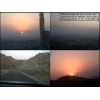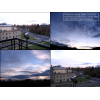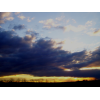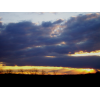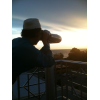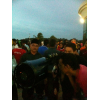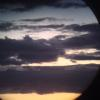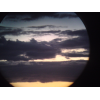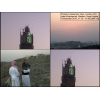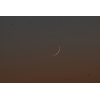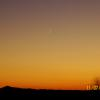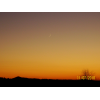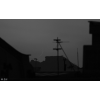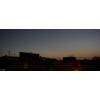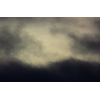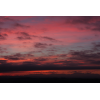نتائج رصد هلال ذو الحجة لعام 1431 هـ
- توقع رؤية هلال أول الشهر (ذو الحجة)
- نتائج تحري هلال أول الشهر (ذو الحجة)
- بداية الشهر الرسمية
- توقع رؤية هلال آخر الشهر (ذو القعدة)
- نتائج تحري هلال آخر الشهر (ذو القعدة)
- بيان المشروع حول رؤية هلال عيد الأضحى
توقع رؤية هلال أول الشهر (ذو الحجة)
سيحدث الاقتران المركزي (المحاق المركزي) يوم السبت 6 تشرين ثان/ نوفمبر 2010 في الساعة 04:52 بالتوقيت العالمي بمشيئة الله
إمكانية رؤية الهلال يوم السبت 6 تشرين ثان/ نوفمبر 2010 و يوم الأحد 7 تشرين ثان / نوفمبر 2010 موضحة في الأشكال التالية باستخدام برنامج المواقيت الدقيقة باعتماد معيار عودة، بحيث:-
- رؤية الهلال مستحيلة من المناطق الواقعة في اللون الأحمر بسبب غروب القمر قبل غروب الشمس أو/و بسبب حصول الاقتران السطحي بعد غروب الشمس.
- رؤية الهلال ممكنة باستخدام التلسكوب فقط من المناطق الواقعة في اللون الأزرق.
- رؤية الهلال ممكنة باستخدام التلسكوب من المناطق الواقعة في اللون الزهري، ومن الممكن رؤية الهلال بالعين المجردة في حالة صفاء الغلاف الجوي التام والرصد من قبل راصد متمرس.
- رؤية الهلال ممكنة بالعين المجردة من المناطق الواقعة في اللون الأخضر.
- رؤية الهلال غير ممكنة بالعين المجردة أو بالتلسكوب من المناطق غير الملونة، على الرغم من غروب القمر بعد غروب الشمس ومن حصول الاقتران السطحي قبل غروب الشمس، وذلك بسبب قلة إضاءة الهلال و/أو بسبب قربه من الأفق.
- يرجى ملاحظة أن الأشكال أدناه تبين إمكانية رؤية الهلال في المناطق الواقعة بين خطي عرض 60 شمالا و60 جنوبا.
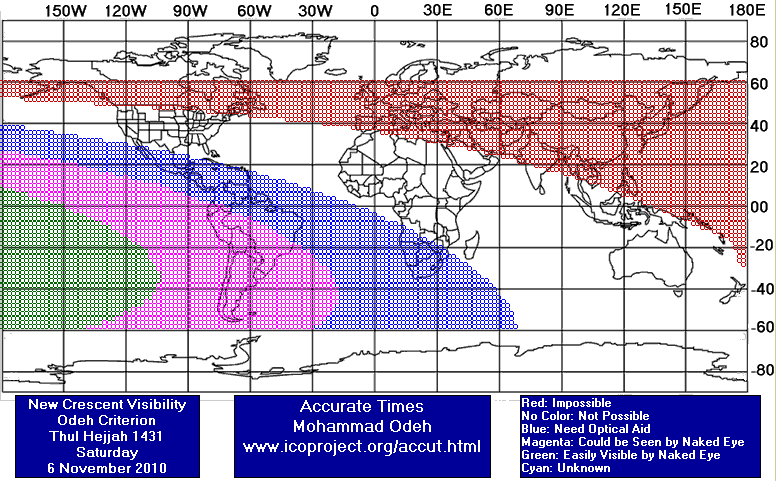
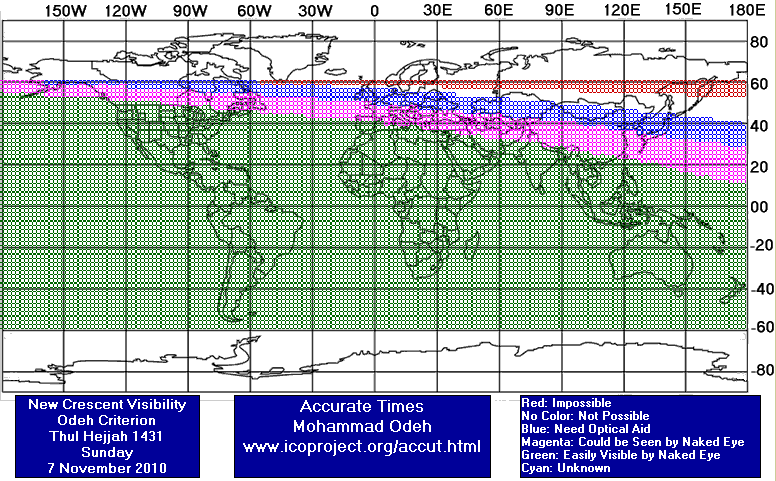
باعتماد التقويم الهجري العالمي المبني على حساب إمكانية رؤية الهلال، فإن بداية الشهر في النطاق الشرقي تكون يوم الأحد 7 تشرين ثان / نوفمبر 2010، وبداية الشهر في النطاق الغربي يوم الأحد 7 تشرين ثان / نوفمبر 2010. الرجاء ملاحظة أن التقويم الهجري العالمي يعتمد على الحسابات المسبقة ( اي لا ينتظر الرصد العملي و رؤية الهلال ) و هو يتبنى معياراً معينا لبدء الشهر الهجري الجديد .و قد تتبنى بلدك او منظمتك معياراً آخر لبدء الشهر لذا فإننا ننصح و بشدة أن يتم الاطلاع عما جاء في صفحة التقويم الهجري العالمي في موقعنا قبل إصدار اي أحكام .
ستضاف نتائج تحري الهلال وبداية الشهر الرسمية في مختلف الدول الإسلامية في هذه الصفحة إن شاء الله فور استلام نتائج الرصد من قبل أعضاء المشروع الإسلامي لرصد الأهلة.
نتائج تحري هلال أول الشهر (ذو الحجة)
السبت 06 نوفمبر 2010
المملكة العربية السعودية
وقال عضو المشروع المهندس قمر الدين "This report was sent by email to ICOUK by Shaykh Sulayman Gani from UK, visiting Makkah for Hajj. Shaykh Sulayman Gani Said: "On Saturday 6 November, I took a taxi to Jabal Khandamah in Makkah Makarramah before Maghrib Salaat. We reached the top of the mountain well before sunset. The two of us attempted sighting of the hilal for the month of Dhil Hijjah with the naked eye after sunset. It was very misty below the western horizon. The hilal could NOT be sighted with the naked eye. Please see attached photos taken with blackberry phone." Note that none of the 10 Saudi Hilal Committees saw the Dhul Hijjah Hilal on (6 Novemeber 2010) by naked eye, binoculars or telescopes. However, the usual persons from near Riyadh (Shaqra) claimed sighting, which were accepted by the Saudi Supreme Court."
وقال عضو المشروع السيد صالح الصعب "The crescent was 0.25 of one degree above horizon at sunset."
المملكة المتحدة
وقال عضو المشروع المهندس قمر الدين "On Saturday 6 November 2010 (29 Dhul Qaidah 1431 AH) many people from throughout UK have attempted to sight the crescent moon (Hilal) of Dhul Hijjah after sunset. None of the groups were able to sight the Hilal even though some places had clear sky (see photos). We have not received any reliable sighting news (Muhaqaq Ruyat-e-Basari) from any countries east of UK/Morocco either (including negative sighting report from South Africa). Therefore, the Ulama in UK (including Wifaq/Bately) have decided that the month of Dhul Qaidah 1431 AH will complete 30 days and the month of Dhul Hijjah 1431 AH will start from Monday 8 November 2010 (i.e. Eid ul Adha on Wednesday 17 November 2010), Insha-Allah. Eid Mubarak to all Muslims. May Allah accept our celebrations and sacrifices (Ameen)."
النرويج
وقال عضو المشروع المهندس عمران مشتاق "According to Islamic Council of Norway , the Hijricalender agreement for Norway, the 1st Dhul Hijja starts on sunday 7.11.2010 and Eid-ul-Adha will inshaAllah be 16.11.2010. Blessed Hajj and Eid."
الولايات المتحدة
وقال عضو المشروع الدكتور جواد تورابنيجاد "This evening, the crescent moon of Thul Hijjah was not sighted in Blacksburg, VA, using optical aids (binoculars: 7X50 and 10X50). I arrived at my sighting location at 5:54 (sunset: 6:18 pm EDT) and started looking for the crescent in the expected area within a clearing streak in a mostly cloudy western horizon. I stayed there till 6:34 pm (moonset: 6:28 pm EDT). At 6:20 pm, the temperature, relative humidity, and pressure were 2 C, 56%, and 1025 mbar, respectively. Earlier today, using binoculars I attempted a daytime sighting with no success. The sighting was on and off for a period of about 4 hrs starting around noon. Venus was sighted at 12:25 pm, first with a pair of binoculars and then with naked eye."
باكستان
وقال عضو المشروع السيد علام سلطان "Not seen all over Pakistan and in Madinah and Dhahran (Saudi Arabia) Today, on my request, nearly 100 persons ( members of the moon-sighting committees of our institute "JAMIA-TUR-RASHEED" + my friends + their companions) tried to sight the moon all over Pakistan at more than 21 places but the moon could not be sighted, as it was astronomically expected tonight. Almost it was clear sky all over Pakistan. Note 1: Today (Saturday, 6 November 2010 = Pakistan: 28 Zul-qa'dah 1431 / Saudi Arabia also 28 Zul-qa'dah according to official announcement based on visibility of moon / according to ummul-Qura calendar 29 Zul-qa'dah), it was certain that the crescent would not be sighted anywhere in Pakistan because moonset was before sunset all over Pakistan and nearly with the sun all over Saudi Arabia. Moreover, it was 28th day in both Pakistan and Saudi Arabia, therefore there was no need to try to sight the moon in Pakistan, but in spite of these facts, I requested our members in Pakistan to sight the moon due to 2 reasons: (1) To increase the trust of common people in the Science of Moon-sighting (2) People were confused due to incomprehensible official Saudi call to sight the moon on 28th day in Saudi Arabia. Note 2: My 2 respected teacher and friend are this time in Madinah (Saudi Arabia). They tried to sight the moon by naked eyes but not sighted as it was expected astronomically. Sky was clear. Note 3: Br Qaiser Imam of hilalsighting.org, also informed me that he tried to see the moon in Dhahran, Saudi Arabia but he was not able to see the moon. Note 4: Saudi supreme court has announced that moon has been sighted in Saudia thus Sunday 7th November is 1st Zul-hijjah in Saudia"
ترينيداد وتوباغو
جنوب أفريقيا
ماليزيا
وقال عضو المشروع السيد قاسم بهالي "The hilal sighting ceremony was held at Al Khawarizmi observatory at Tg. Bidara Melaka, led by the Mufti of Melaka state and more 100 muslim communities gathered here to observed the hilal but the hilal was not seen. The western sky was partly cloudy . The hilal was not seen even through the Meade 8” LX200, giant binocular and Theodolite . The 1st Zulhijah 1431 begins on Monday , 8 November, was officially announced by the authority through the radio and TV channels."
الأحد 07 نوفمبر 2010
أستراليا
وقال عضو المشروع السيد أفروز على "The crescent on 7th November was sighted in numerous cities around Australia."
الإمارات
الجزائر
وقال عضو المشروع السيد حسين الشيخ عيسى "More than 21 persons were prensent in N'tissa station. Thul Hijjah 1431 crescent was seen by naked eyes and by binoculars (03). Aide Mubarek for all Muslimeen, thank's"
العراق
وقال عضو المشروع الدكتور عبدالستار محمد خضر "Some strips of dark clouds were seen at the altitudes between 2-4 degrees above west horizon which was orange to red. The crescent appeared down from the lowest strip which was about 2 degrees above the horizon. It was completely seen under this horizon and lasts about 2-3 minutes. Its color was orange. It dissappeared in the dark backgound about 1 degree above the apparent horizon. I used redshift 7 to help esitmating the crescent position and times. My son Mohammed_Younis (13 years old) had also seen it."
ألمانيا
المملكة العربية السعودية
وقال عضو المشروع المهندس قمر الدين "This report was sent by email to ICOUK by Shaykh Sulayman Gani from UK, visiting Makkah for Hajj. Shaykh Sulayman Gani Said: "On Monday, 8 November here in the Holy City of Makkah Mukarramah the five of us sighted the hilal easily after the sunset with the naked eye from the top of Jabal (mountain) Khandamah. Easily visible on the top and slightly to the right of the New Clock Tower. Please see the attached photos taken with blackberry phone". Note that the majority of the UK ulama (including Wifaq, Batley, Confederation of Sunni Mosques etc) have agreed to start the month of Dhul Hijjah 1431 from Monday 8 November 2010 (i.e. Eid-ul Adha on Wednesday 17 November 2010), Insha-Allah."
الولايات المتحدة
وقال عضو المشروع الدكتور جواد تورابنيجاد "Today (Sunday, November 07, 2010), my daughter, and I were able to sight the moon in Blacksburg, VA. Upon arrival at our sighting location, we sighted the crescent at 5:36 pm EST with naked eye (sunset at 5:17 pm EST). At 5:44, the crescent was about 4.5 degrees above the horizon. The horns were at 1:30 and 6:30 O'clock (1:30;3:30;6:30). At 5:40 pm, the temperature, dew point, relative humidity, and pressure were 6 C, -5 C, 46%, and 1024 mbar, respectively. We left at 6:00 (moonset at 6:19 pm EST). The sky was clear with some haze. Earlier in the day, around 11:32 am EST, I tried a daytime crescent sighting with success. At 11:50 am, I was able to see Venus, first using a pair of binoculars (7X50) followed by naked eye. Eight minutes later, at 11:58 am EST, I sighted the crescent using the binoculars. The horns were at 11:45 and 3:45 (11:45;1:45;3:45). Later, my daughter, son, and wife sighted the moon as well, using the binoculars. At 12:00, the temperature, dew point, relative humidity, and pressure were 6 C, -4 C, 49%, and 1028 mbar, respectively. It took three more hours before I was able to see the moon with naked eye at 2:58 pm. At 3:00 pm, the temperature, dew point, relative humidity, and pressure were 7 C, -5 C, 43%, and 1025 mbar, respectively. I stopped following the moon at 3:16 pm. The sky was mostly clear with passing clouds and hazy. Note: I used the Sky & Telescope Interactive Sky Chart. "
إيران
باكستان
وقال عضو المشروع السيد علام سلطان "Not seen by me / Easily seen by other countrywide On my request, Today (Sunday, 7 November 2010 = 29 Zul-qa'dah 1431 in Pakistan) more than 200 persons (Members of the moon-sighting committees of our institute "JAMIA-TUR-RASHEED" + my friends + their companions) easily sighted the crescent at more than 9 places countrywide. As it was very hazy in Karachi hence I and my other friends could not sight the moon in Karachi. Note 1: Chairman of central official moon sighting committee of Pakistan mufti Munee-bur-Rahman told me on my mobile phone that they have sighted the moon in Islamabad and have received many positive reports countrywide thus he officially announced that 1st Zul-hijjah 1431 will be on Monday 8 November 2010 in Pakistan after ending the 29 days of Zul-qa'dah 1431. Note 2: After some days, inshaallah, a detailed report of this observation will be available at www.esnips.com/web/moonnewsofjamiaturrasheed "
بنغلادش
وقال عضو المشروع السيد أبم حسان "The crescent was seen right after the sunset. We received first sighting report from coxsbazar our eastern-southern part of the country.The sky was clear and atmospheric condition was superb."
عُمان
وقال عضو المشروع الأستاذ دكتور محمد سالم البوسعيدي "The western sky was very clouded. We managed to image it with a Takahashi FSQ 106ED and CCD."
غانا
وقال عضو المشروع السيد عبد العزيز أنيانج "The National Hilal members from the office of the National Chief Imam of which I am a member met yesterday at 1530 GMT to deliberate on which day and date to celebrate the Eid Adha. Usually with Idil Adha, whatever decision that comes from the Kingdom of Saudi Arabia (KSA) is accepted even if it is not the correct date for the day of Arafat (in this case Monday the 15th of November, 2010). During the meeting I presented documents from the KSA indicating that their day of celebration is Tuesday the 16th of November, 2010. I then explained that it was not possible for the KSA to sight the crescent on Saturday November 6, 2010 at their local time as it was just not possible. Ghana on that day (November 6, 2010) had a very clear weather but no crescent was seen on that day. If really the KSA had seen the actual crescent (which they did not see), Ghana will have seen it too. They are just following their latest criteria of “if the moon sets after the sun by even a second”! How is it possible to claim under these local Sunset and Moonset times in the KSA that the crescent for Dhul Hijja 1430 AH had been seen under these local Sunset (SS) and Moonset (MS) times? (Makkah – SS 5.42pm & MS 5.47pm), (Riyadh – SS 5.10pm & MS 5.12pm) and (Madina – SS 5.39pm & MS 5.42pm). I made it clear that it is time not to follow the KSA in the celebration of Idil Adha if it is clear that they are not following the truth. Yesterday (Sunday November 07, 2010) at our local time 1815 hrs we had a very cloudy weather at my area but the it was seen by one of the groups who are fisher folks by the coastline. With this confirmation, Tuesday Nov 16th should have been the day of Arafat and Wednesday November 17th Idlil Adha, but as it stands now, decision based on KSA had been accepted; hence Tuesday November 16th will be the day of celebration. I know the jihad by muslim groups all over the world(even some in the Kingdom of Saudi Arabia) are doing their best to let the KSA do the right thing, but these our brothers in KSA will just not listen. It is time those countries that follow wrongful decisions coming from the KSA in the start of the two major festivals in the Islamic lunar calendar to refrain from doing so and accept only the right decisions. "
بداية الشهر الرسمية
الأحد 07 نوفمبر 2010
1 . الأردن
2 . الإمارات
3 . البحرين
4 . السودان
5 . العراق
6 . الكويت
7 . المملكة العربية السعودية
8 . النرويج
9 . اليمن
10 . سوريا
11 . عُمان
12 . غانا
13 . فلسطين
14 . قطر
15 . لبنان
16 . ليبيا
17 . مصر
الإثنين 08 نوفمبر 2010
1 . أستراليا
2 . المملكة المتحدة
3 . أندونيسيا
4 . إيران
5 . باكستان
6 . بنغلادش
7 . ترينيداد وتوباغو
8 . جنوب أفريقيا
9 . ماليزيا
توقع رؤية هلال آخر الشهر (ذو القعدة)
سيحدث الاقتران المركزي (المحاق المركزي) يوم السبت 6 تشرين ثان/ نوفمبر 2010 في الساعة 04:52 بالتوقيت العالمي بمشيئة الله
إمكانية رؤية هلال آخر الشهر يوم السبت 6 تشرين ثان/ نوفمبر 2010 و يوم الجمعة 5 تشرين ثان/ نوفمبر 2010 موضحة في الأشكال التالية باستخدام برنامج المواقيت الدقيقة باعتماد معيار عودة، بحيث:-
- رؤية هلال آخر الشهر مستحيلة من المناطق الواقعة في اللون الأحمر بسبب شروق القمر بعد شروق الشمس أو/و بسبب حصول الإقتران السطحي قبل شروق الشمس.
- رؤية هلال آخر الشهر ممكنة باستخدام التلسكوب فقط من المناطق الواقعة في اللون الأزرق.
- رؤية هلال آخر الشهر ممكنة باستخدام التلسكوب من المناطق الواقعة في اللون الزهري، ومن الممكن رؤية الهلال بالعين المجردة في حالة صفاء الغلاف الجوي التام والرصد من قبل راصد متمرس.
- رؤية الهلال ممكنة بالعين المجردة من المناطق الواقعة في اللون الأخضر.
- رؤية الهلال غير ممكنة بالعين المجردة أو بالتلسكوب من المناطق غير الملونة، على الرغم من شروق القمر قبل شروق الشمس ومن حصول الإقتران السطحي بعد شروق الشمس، وذلك بسبب قلة إضاءة الهلال و/أو بسبب قربه من الأفق.
- يرجى ملاحظة أن الأشكال أدناه تبين إمكانية رؤية الهلال في المناطق الواقعة بين خطي عرض 60 شمالا و60 جنوبا.
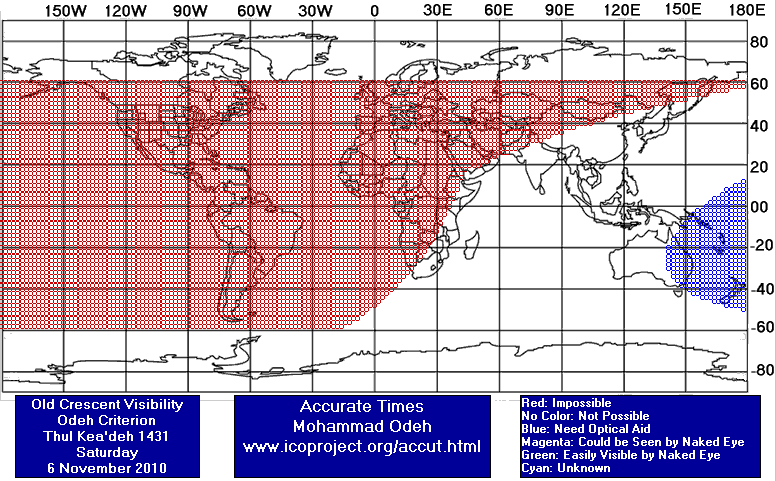
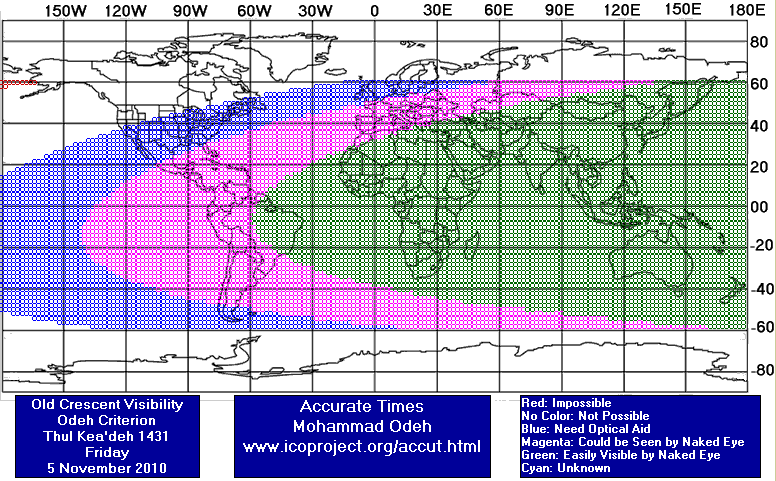
نتائج تحري هلال آخر الشهر (ذو القعدة)
الجمعة 05 نوفمبر 2010
ألمانيا
وقال عضو المشروع المهندس مارتن إليسياسر "The old crescent of 5. November was very close to venus, when it rose in the south east. This should have been a beautiful sight, but layers of clouds made the observation difficult. Arriving somewhat late at the site, i missed the actual moonrise, but had my first view of venus, when the moon had already entered the lowest layer of clouds. I could see venus repeatedly through the clouds during the next half hour, but was not able to visually spot the thin lunar crescent (using a pair of 8x32 binoculars) through the moving and distracting clouds. Still, as i also took many images with a DSLR and a 500mm lens, i could identify the crescent on these images later. So, this probably counts as "Seen by CCD imaging"."
المملكة المتحدة
وقال عضو المشروع المهندس قمر الدين "On Friday 5 November 2010 morning I have tried to sight the waning crescent of Dhul Qaidah 1431, but the sky was totally cloudy, I was unable to sight the old crescent."
بيان المشروع حول رؤية هلال عيد الأضحى
الثلاثاء 16 نوفمبر في بعض الدول الإسلامية، والأربعاء في دول أخرى
بدأت العديد من الدول الإسلامية شهر ذي القعدة يوم السبت 09 تشرين أول/أكتوبر، وبالتالي ستتحرى هذه الدول هلال شهر ذي الحجة يوم السبت 06 تشرين الثاني/نوفمبر. ورؤية الهلال في ذلك اليوم غير ممكنة لا بالعين المجردة ولا باستخدام التلسكوب من جميع مناطق العالم الإسلامي بما في ذلك جميع أجزاء أستراليا وآسيا وأوروبا ومعظم أجزاء أفريقيا، في حين أنه من الممكن رؤية الهلال باستخدام التلسكوب من أقصى جنوب القارة الإفريقية وأمريكا الوسطى والجنوبية. وحيث أن الهلال يوم السبت 06 تشرين الثاني/نوفمبر سيغيب بعد الشمس وأن هناك إمكانية لرؤيته من مكان ما في العالم في ذلك اليوم، فإن بعض الدول الإسلامية تعتبر ذلك كافيا لبدء الشهر وستبدأ شهر ذي الحجة يوم الأحد 07 تشرين الثاني/نوفمبر ليكون بذلك يوم الثلاثاء 16 تشرين الثاني/نوفمبر أول أيام عيد الأضحى فيها.
أما بالنسبة للدول التي تشترط رؤية الهلال من داخل أراضيها والتي لن تمكن رؤية الهلال منها يوم السبت أو الدول التي ستتحرى الهلال يوم الأحد مثل سلطنة عمان والمملكة المغربية وباكستان وإيران، فمن المتوقع أن تبدأ شهر ذي الحجة يوم الاثنين 08 تشرين الثاني/نوفمبر ليكون بذلك يوم الأربعاء 17 تشرين الثاني/نوفمبر أول أيام عيد الأضحى فيها. ومن الجدير بالذكر أن هناك العديد من الدول الإسلامية التي لا تشترط بدء شهر ذي الحجة مع المملكة العربية السعودية، بل لها معايير وشروط معينة قد تتفق أحيانا مع إعلان السعودية وقد تختلف أحيانا أخرى، ومن هذه الدول أندونيسيا وماليزيا وبروناي والهند وباكستان وإيران وتركيا وعُمان وليبيا والمغرب ومعظم الدول الإسلامية غير العربية في إفريقيا.
وبإلقاء نظرة على وضع القمر يوم السبت 06 تشرين الثاني/نوفمبر في بعض المدن العربية والإسلامية، نجد أن الحسابات السطحية للهلال عند غروب الشمس كما يلي:
- مدينة أبو ظبي سيغيب القمر بعد دقيقة واحدة من غروب الشمس، وسيكون عمره 10 ساعة و35 دقيقة،
- مدينة مكة المكرمة سيغيب القمر بعد 05 دقائق من غروب الشمس، وسيكون عمره 11 ساعة و41 دقيقة،
- مدينة عمّان سيغيب القمر قبل دقيقة واحدة من غروب الشمس وسيكون عمره 11 ساعة و39 دقيقة،
- مدينة القاهرة سيغيب القمر بعد دقيقة واحدة من غروب الشمس، وسيكون عمره 11 ساعة و55 دقيقة،
- مدينة الرباط سيغيب القمر بعد 03 دقائق من غروب الشمس، وسيكون عمره 13 ساعة و58 دقيقة،
هذه القيم تعني أن رؤية الهلال يوم السبت في كل من أبوظبي وعمّان والقاهرة ومكة المكرمة والرباط ستكون غير ممكنة لا بالعين المجردة ولا باستخدام التلسكوب.
ولمعرفة معاني هذه الأرقام تجدر الإشارة إلى أن أقل مكث لهلال أمكنت رؤيته بالعين المجردة كان 29 دقيقة وتمت رؤيته يوم 20 أيلول/سبتمبر 1990م من فلسطين، أما أقل عمر هلال أمكنت رؤيته بالعين المجردة فكان 15 ساعة و 33 دقيقة وتمت رؤيته يوم 25 شباط/فبراير 1990م من الولايات المتحدة. ولا يكفي أن يزيد عمر القمر ومكثه عن هذه القيم لتمكن رؤيته، إذ أن رؤية الهلال متعلقة بعوامل أخرى كبعده الزاوي عن الشمس و بعده عن الأفق لحظة رصده.
ولمعرفة نتائج رصد هلال شهر ذي الحجة يمكن زيارة موقع المشروع الإسلامي لرصد الأهلة على شبكة الإنترنت على العنوان (http://www.icoproject.org) حيث أنشئ المشروع عام 1998م ويضم حاليا أكثر من 400 عضو من علماء ومهتمين برصد الأهلّة وحساب التقاويم ومختلف قضايا الفلك الشرعي. هذا ويشجع المشروع المهتمين في مختلف دول العالم على تحري الهلال و إرسال نتائج رصدهم إلى المشروع عن طريق موقعه على شبكة الإنترنت، حيث تنشر تباعا بعد تدقيقها وتمحيصها.
